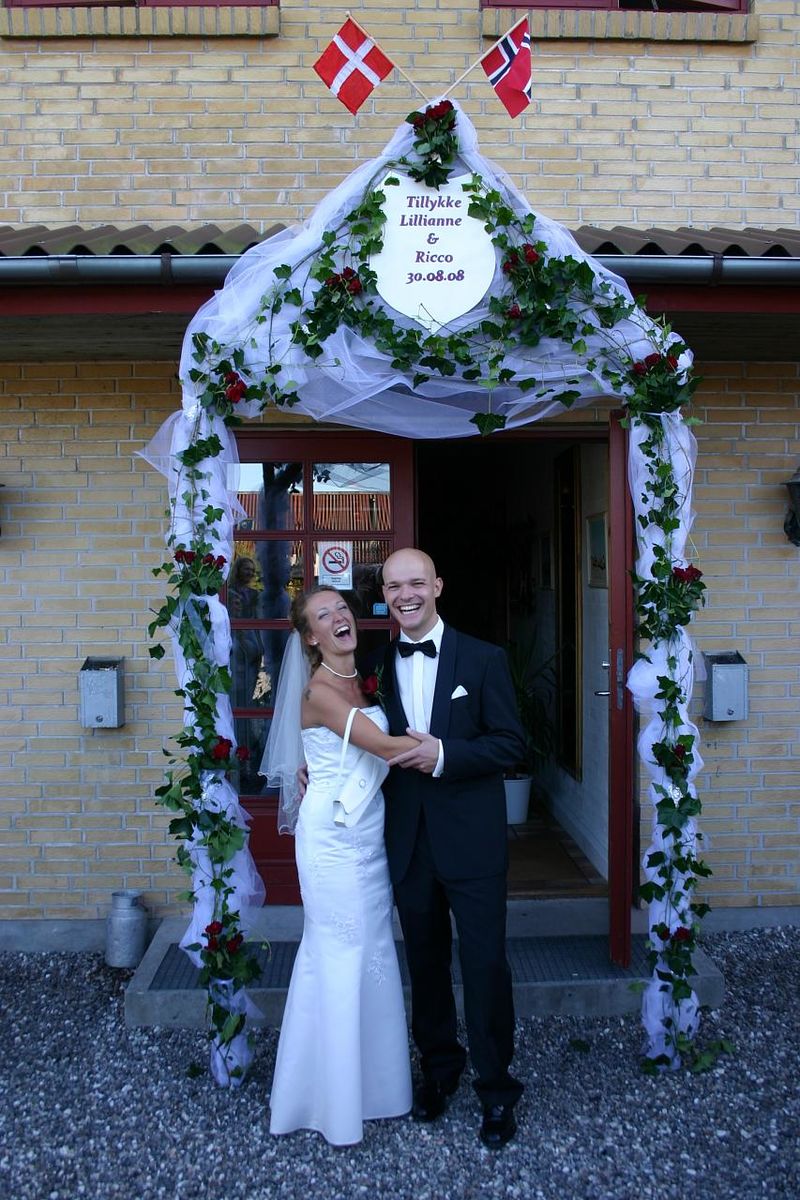Danish Wedding
Danish weddings feature unique customs such as the "gate of honour" made from pine branches and flowers, and traditions like the groom buying the bridal bouquet while the bride buys her own wedding shoes. The wedding reception involves various rituals, including the "brudevals" waltz danced before midnight, guests cutting the groom's sock tips, and the couple kissing under a table while guests stamp their feet. Celebrations conclude with the cutting of the traditional "kransekage" cake and playful traditions where guests clink silverware for the couple to kiss, followed by sending thank-you cards with photos to guests.
Danish Weddings
On the wedding day an archway known as "gate of honour" ("æresport") is placed around the door to the bride's home or somewhere close to it. It is made of pine branches and various flowers. The gate of honour is made by the family members, friends and neighbours. Some people put the gate of honour on the door to the place where wedding ceremony or wedding reception are organized. The "gate of honour" is made again on the 25th wedding anniversary.
A Danish bride traditionally wears a white wedding dress and a veil. So the female guests should not wear white clothes. The bride also has something red. In Denmark this colour symbolizes love. Some also believe that it also wards off evil spirits. The bridal bouquet is bought by the groom.
The groom should not buy the wedding shoes for his bride. She must get them by herself. She should not sell them after the wedding.
Wedding ceremony can be held in church or in the state office registered for the purpose. Traditionally bride and her father are those who arrive last. Usually it is about 5 minutes before the ceremony. After the wedding ceremony rice is thrown at the newlyweds. It symbolizes fertility.

Usually there are less then 100 guests present at the wedding reception. When guests arrive at the wedding reception and find their seat they stay standing until they are given a sign that everybody should take a seat. Taking a seat on your own is considered impolite.
The whole event is managed by the toast master. There are several speeches made during the wedding reception. The first one who is going to speak is the bride's father.
There is lot of singing. People often change the lyrics of a famous song so it relates to the newlyweds. Such lyrics are printed and given to the guests so everyone can sing.
The bride dance is a waltz. Danes believe that "brudevals" must be danced before midnight. The music for the waltz is from the ballet "A folk tale" (1854) by the Danish composer Niels Wilhelm Gade (1817-1890). While dancing the couple is surrounded by the guests. They slowly getting closer towards the couple. At the end of the dance there will be no more free space. The bride and groom then kiss.
Immediately after that the male guests will take off groom's shoes. The best man then cuts the tips of his socks. This is done to prevent the groom seduce other woman than his wife. Some say that the reason is completely different. They say that the cut tips are given to the bride who should then repair the socks and show that way that she is going to be a good wife.
Bride's veil is destroyed by the guests. It is done as it is believed that she won't need it anymore.
The traditional wedding cake called "kransekage" is cut by the happy couple sometime around midnight. Each guest must get a slice. Otherwise the couple will have a bad marriage. The "kransekage" is often decorated with small Danish flags.
The wedding reception in Denmark includes a bit unusual tradition. A guest starts stamping on the floor. Other guests join him or her. The newlyweds then hide under a table and kiss.
The next tradition is let's say rather noisy. Guests take parts of the silverware and start striking glasses or plates. That is the sign that the bride and groom have to stand up on chairs and kiss.
There is even more kissing. When the bride has to go to the toilet. Female guests rush to kiss the groom. It is the same with groom.
After the wedding the couple sends kind of a "thank you card" to all guests. Usually it is a photo.
References
Danish Wedding Traditions
http://www.worldweddingtraditions.net/danish-wedding-traditions/
Danish Wedding Traditions
http://www.ingebretsens.com/culture/weddings/dan-wed-tradition
Danish wedding traditions?
http://www.reddit.com/r/Denmark/comments/1e1j9q/danish_wedding_traditions/
Niels Gade
https://en.wikipedia.org/wiki/Niels_Gade
Traditional Danish wedding with all the customs, beauty and fun
http://www.earthoria.com/traditional-danish-wedding-with-all-the-customs-beauty-and-fun.html
Danish Wedding Traditions Explained
http://joyfultx.blogspot.com/2013/04/danish-wedding-traditions-explained.html
Image(s)
gate of honour (photo by Ricco Førgaard, Flickr)
https://www.flickr.com/photos/fiskeben/2814217007
Creative Commons - File:Nyhavn 5-15, Kbh 2020.jpg